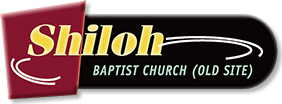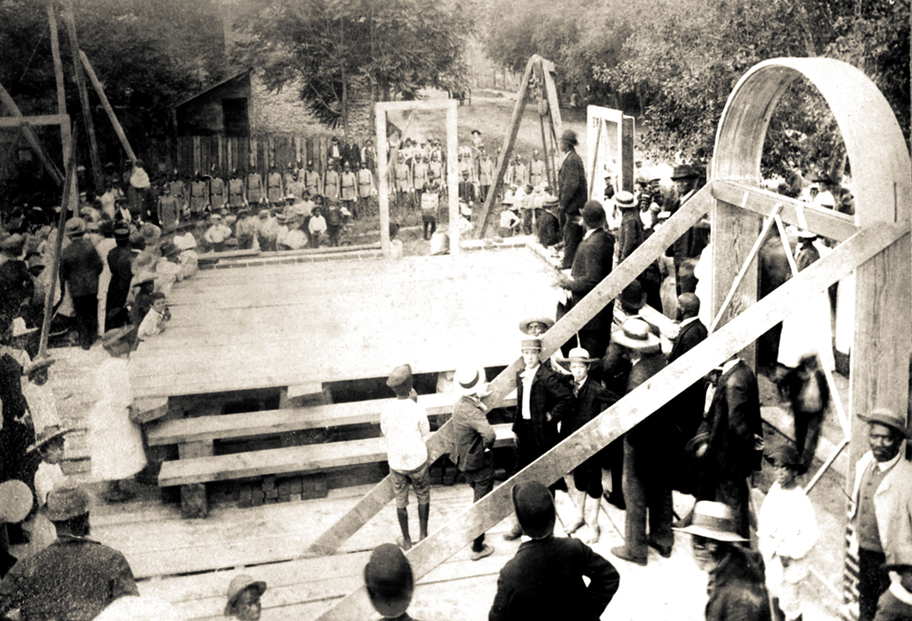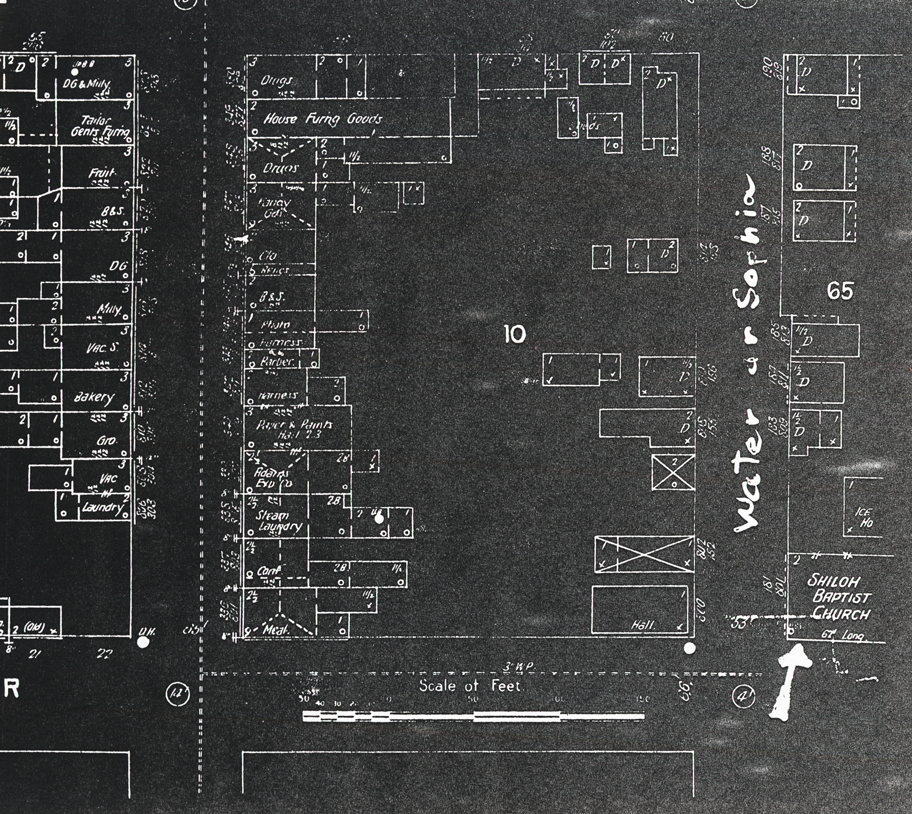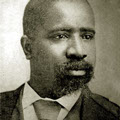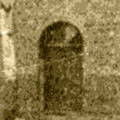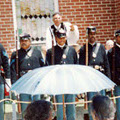1890 ::: A Moment in Time
A partial list of church members from 1890
This list is very incomplete. Many records have been lost. We do know, however, that each of the following was an active member of the church in 1890:
James Anderson ::: He served in 1890 as a member of the building and finance committee.
Jeremiah Bankhead ::: He served in 1890 as a trustee.
Ellen A. Brookes ::: She served in 1890 as the secretary of the Sunday school.
John Brooks ::: He served in 1890 as a deacon and as a member of the building and finance committee.
James E. Brown ::: He served in 1890 as the church's pastor, the secretary of the building and finance committee, and as a teacher in the Sunday school. (See small photos on this page.)
Lizzie Bumbrey ::: She served in 1890 as a member of the congregation's advisory board.
Caroline Burrell ::: She served in 1890 as a member of the congregation's advisory board.
William Burrell ::: He served in 1890 as chair of the building and finance committee.
Georgina Butler ::: She served in 1890 as a member of the choir.
Amanda Carter ::: She served in 1890 as a member of the congregation's advisory board.
Brodie Carter ::: She served in 1890 as a member of the choir.
L. Carter ::: He served in 1890 as a member of the choir.
Sarah Coleman ::: She served in 1890 as a member of the choir.
Hellen Courtney ::: She served in 1890 as a member of the choir.
Melvina Day ::: She served in 1890 as a member of the congregation's advisory board.
Henry Dean ::: He served in 1890 as the church clerk and as treasurer of the building and finance committee.
L. Frazer ::: He served in 1890 as a member of the choir.
Daphne Gilmore ::: She served in 1890 as a member of the choir.
Mary E. Gray ::: She served in 1890 as a member of the congregation's advisory board.
Lucy A. Hayes ::: She served in 1890 as a member of the choir.
Rhoda Hughes ::: She served in 1890 as a member of the congregation's advisory board.
Andrew Jackson ::: He served in 1890 as a deacon and as a member of the building and finance committee.
H. H. Jackson ::: He served in 1890 as a deacon and as a member of the building and finance committee.
Mary E. Jackson ::: She served in 1890 as a member of the congregation's advisory board.
S. E. D. Jackson ::: She served in 1890 as a member of the congregation's advisory board.
James D. Johnson ::: He served in 1890 as a member of the building and finance committee.
Julia Johnson ::: She served in 1890 as a member of the congregation's advisory board.
Sarah Johnson ::: She served in 1890 as the organist for our choir, probably using a small pump organ.
John Lomax ::: He served in 1890 as a member of the choir.
Andrew Lucas ::: He served in 1890 as a member of the choir.
Eliza Lucas ::: She served in 1890 as a member of the congregation's advisory board.
John Turner Lucas ::: He served in 1890 as a trustee and as a member of the building and finance committee.
Mariah Lucas ::: She served in 1890 as a member of the congregation's advisory board.
Mary Lucas ::: She served in 1890 as a member of the congregation's advisory board.
Robert E. Lucas ::: He served in 1890 as a trustee.
R. H. Lucas ::: He served in 1890 as the superintendent of our Sunday school, which had an enrollment in 1890 of 165 scholars, with an average attendance of 123.
William H. Lucas ::: He served in 1890 as a member of the choir.
Stapleton Miller ::: He served in 1890 as a trustee and as a member of the building and finance committee.
Patsy Myers ::: She served in 1890 as a member of the congregation's advisory board.
Thomas Myers ::: He served in 1890 as a member of the choir.
Frank Phillips ::: He served in 1890 as a deacon, church treasurer, Sunday school treasurer, and a member of the building and finance committee.
Hattie Phillips ::: She served in 1890 as a member of the congregation's advisory board.
Lindsay Robertson ::: He served in 1890 as a member of the building and finance committee.
Eliza Roy ::: She served in 1890 as a member of the congregation's advisory board.
John L. Russell ::: He served in 1890 as a deacon.
Bettie (Betty) Scott ::: She served in 1890 as a member of the congregation's advisory board and as the organist for the Sunday school.
Louisa Scrannage ::: She served in 1890 as a member of the choir.
Edmund Sprow ::: He served in 1890 as a deacon.
A. W. Taylor ::: He served in 1890 as a member of the choir.
Melvina Triplett ::: She served in 1890 as a member of the congregation's advisory board.
Rosa Tucker ::: She served in 1890 as a member of the choir.
Elmore Washington ::: He served in 1890 as a deacon.
Martha Ann Washington ::: She served in 1890 as a member of the choir.
Susan H. White ::: She served in 1890 as a member of the choir.
E. Wormley ::: He served in 1890 as a trustee.
Susan Wormley ::: She served in 1890 as a member of the choir.
Robert W. Wright ::: He served in 1890 as a deacon.
Cornerstone laying ceremony, June 18, 1890
A large crowd gathered on Wednesday evening, June 18, 1890, for festivities marking the laying of a cornerstone for the complete rebuilding of our original edifice, which had tragically collapsed in 1886. The firm of Charles G. Heflin & Brothers, local carpenters and builders, had been engaged to undertake the construction.
The cornerstone laying ceremony is pictured at the top of this web page.
The Garfield Light Infantry was on hand, as were local members of the Free Masons, specifically Fredericksburg Lodge No. 4, A. F. & A. M.
The festivities began with the singing of "Hymn 808," which was "read" by our pastor, the Rev. James E. Brown. (This "reading" probably involved the pastor speaking the words of each line of the hymn before it was sung by the assembled congregation. This was a common practice in those days, reducing the number of expensive hymnals that would be required, while also accommodating the needs of those who were not particularly literate.) By the way, we don't know what "Hymn 808" was because no copies of that hymnal have as yet been found.
Scripture was read by the Rev. Dr. James P. Smith. The Rev. Melzi S. Chancellor offered a passionate prayer, seeking God's blessing on the congregation as it resumed worshiping at this historic site.
Many local dignitaries attended, and plates were passed to collect financial donations. The Fredericksburg Star newspaper reported that "a very flattering sum was realized."
We move into our new building, October 26, 1890
Construction on the new building proceeded rapidly, though there was a brief interruption when bodies of fallen Union soldiers were found in shallow graves near where our previous building had stood. These bodies were carefully removed and reburied at the National Cemetery in Fredericksburg.
The new building had two stories, with the sanctuary on the upper level (as it still is today), but there were few frills. Initially, everything was quite simple.
An opening celebration was held on Sunday, October 26, 1890. Three services were held that day. Our pastor, the Rev. James E. Brown, preached at the 11 a.m. service. Another minister who had long been associated with the church, the Rev. Cornelius S. Lucas, preached in the afternoon.
At the evening service that day, the preaching was by the much-loved Rev. George Dixon. Rev. Dixon had been a preaching deacon in our congregation prior to the Civil War (during the years when we had been required to have a white pastor/overseer). During the Civil War, George Dixon had fled from slavery and made his way to Washington, D.C., where he got additional Christian training and was then ordained by Nineteenth Street Baptist Church in Washington. Rev. Dixon returned to Fredericksburg immediately after the war, becoming our first African American pastor, serving in that capacity until 1878. His presence at the evening service helped cap a deeply meaningful day.
